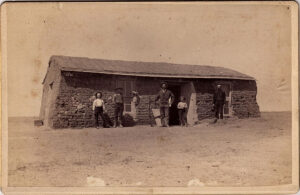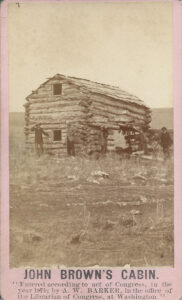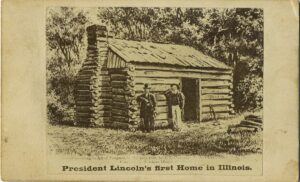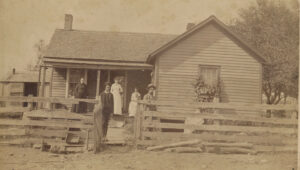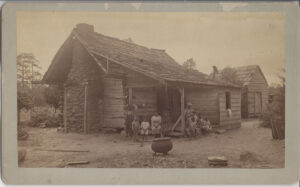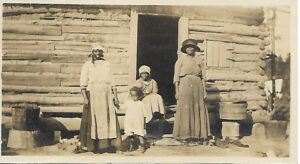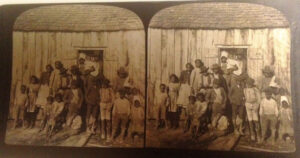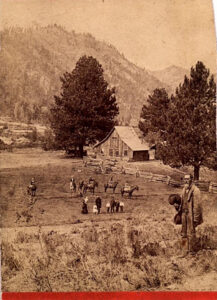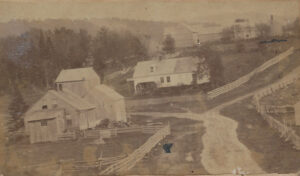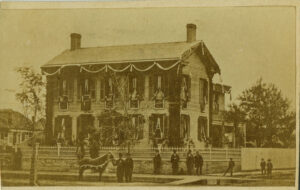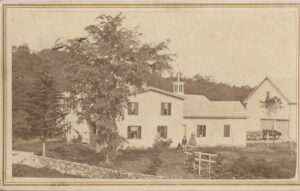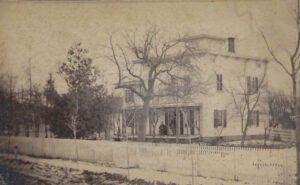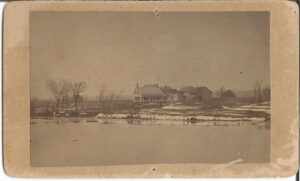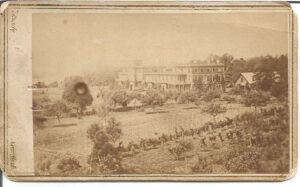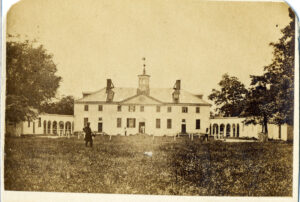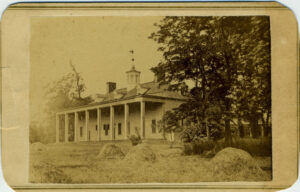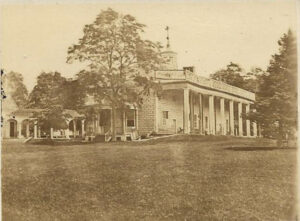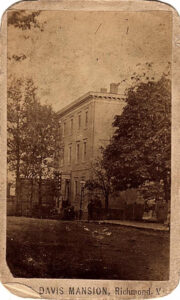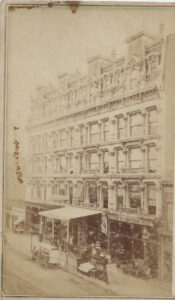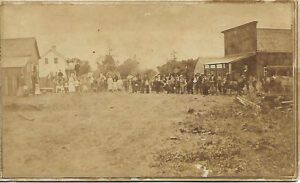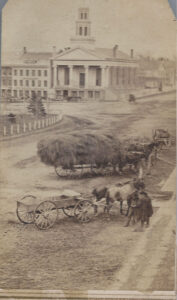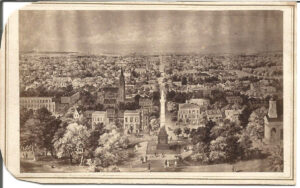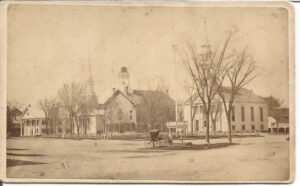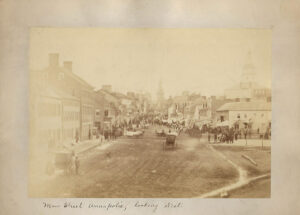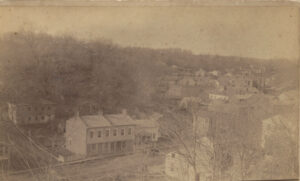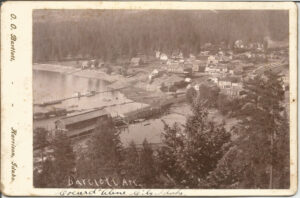Section #3 - Where We Live
Where We Live
You are there:
After the colonists have been settled in America for nearly two centuries, nine in ten of them still live on farms.
Where People Live In 1790
| Location | Percent |
| Rural/farms | 93% |
| Urban/cities | 7 |
Most of these farms are modest in size, with about 40% less than 50 acres, and another 28% between 50 and 100 acres. The exception being plantations which require at least 500 acres to be profitable. A very few far exceed this scale, like William Aiken Junior’s Jehossee Island rice plantation with 4,000+ acres and over 700 enslaved workers at its peak.
Typical Farm Sizes (North Carolina)
| Acres | Percent |
| Under 10 acres | 3% |
| 10-19 | 7 |
| 20-49 | 31 |
| 50-99 | 28 |
| 100-499 | 29 |
| 500-999 | 2 |
| 1000 and over | * |
Housing on these farms differs sharply based on race and wealth.
For almost all of the 698,000 enslaved Black people in the south is consists of run-down wooden shacks, designed to further strip away their dignity and humanity.
For whites the most primitive version is a one story “wattle and daub” shelter, where a lattice (i.e. wattle) of wooden strips is filled in (i.e. daubed) with sticky materials such as grass sod, clay, mud or even dung. More well-off settlers opt for “side passage double pile” homes, at least two stories in height and with two to three rooms on each floor separated by a central aisle. The very few which make the upgrade from wood to bricks belong to the upscale gentry, including the southern planters.
Cooking is mostly done on a hearth set inside a fireplace – although some kitchens are located outside for safety reasons. A few cast iron stoves are beginning to appear by 1790. Water is sourced from a well and toiletry is confined to crude outhouses.
Luxury housing is limited to the very wealthy and marked by construction using bricks rather than wood alone. A unique example is Thomas Jefferson’s mansion at Monticello with its dramatic facing of red bricks and white trim, Doric columns and crown roof, 11,000 square feet of living space, and the latest in mechanical and decorative features.
Meanwhile the relatively few Americans in 1790 who reside in cities are most likely found in major shipping ports along the Atlantic coast handling ocean commerce.
Five Largest Cities In 1790
| Population | |
| New York | 33,131 |
| Philadelphia | 28,522 |
| Boston | 18,320 |
| Charleston | 16,345 |
| Baltimore | 13,503 |
Housing conditions for city dwellers tend to be miserable. Most people are jammed into “row houses” built side by side and often connected to one another by rear yard terraces. They are typically 5-7 stories tall, with a front lot footage of 25 feet and a depth of 100 feet. Inside are cramped apartments housing entire multi-generational families. Access to outside light is limited to street-side lodgings. Ventilation and sanitation are poor. Fire escapes are non-existent and will appear only after repeated losses of life.
For many rural Americans, this “city life” is associated with a host of negative social outcomes: crushing poverty, violent street gangs and rampant crime, drunkenness, bordellos, the path to perdition. Thus few are anxious to move from the farm.
Two other factors also heighten the appeal of farms. First is the ready availability of vast acres of “western” land acquired from France in the 1803 Louisiana Purchase and from Britain after the Revolution and the War of 1812. Second are government policies under Jefferson and his Democrat successors who are committed to an agrarian economy for America.
To meet this goal, the Land Act of 1820 allows a settler to buy a minimum plot of 80 acres for as little as $1.25 per acre, or $120 in total. This is not “dirt cheap” at a time when unskilled laborers are earning 75 cents a day, but it is within reach for anyone able to work out an equitable bank mortgage.
In the 1830’s, various “Pre-emption Acts” are also passed in congress to accommodate “squatters” who have moved onto public domain property without a formal purchase. As long as they can prove they have “cultivated” the land, they are allowed to subsequently buy it at the $1.25 per acre price.
The other barrier to moving from farms to towns and cities is the lack of reliable roads and bridges that allow for centralized marketplaces to form along with basic features such as general stores, hostelries, and taverns. It will takes Henry Clay’s new Whig Party founded in 1833 to promote federal spending on the infrastructure needed for urban centers to take hold.
But the transition from living on farms to living in cities proceeds slowly.
By 1840, only 11% of the population have made the move, and the American dream for the vast majority still lies in saving up enough money buy their own 40-80 acre farms.
“Home” In 1840
| Urban | Rural | |
| 1820 | 7% | 93% |
| 1830 | 9 | 91 |
| 1840 | 11 | 89 |
The only exception lies in the northeastern states where 1 in 5 people are urban dwellers.
% Of Population That Is Urban
| Total US | Northeast | South | West | |
| 1820 | 7% | 11% | 5% | 2% |
| 1830 | 9 | 14 | 5 | 3 |
| 1840 | 11 | 19 | 7 | 4 |
Still by 1840 the importance of cities to America’s future is already coming into focus in New York. Once the 363 mile long Erie Canal links Buffalo with Albany and the Hudson River, the city becomes the hub for commerce between the east coast and the emerging Midwestern states. New York’s population stands at 313, 710, equal to Berlin and trailing only Paris and London on the global stage.
Baltimore and New Orleans also top the 100,000 mark in residents and the inland city of Cincinnati on the Ohio River joins the top ten ranks.
Top Ten Largest Cities In America — 1840
| 1820 | Pop. | 1840 | Pop. |
| New York | 123,706 | New York | 312,710 |
| Philadelphia | 63,802 | Baltimore | 102,313 |
| Baltimore | 62,738 | New Orleans | 102,193 |
| Boston | 43,298 | Philadelphia | 93,665 |
| New Orleans | 21,176 | Boston | 93,383 |
| Charleston | 24,780 | Cincinnati | 46,338 |
| No Philadelphia | 19,678 | Brooklyn | 36,233 |
| So Philadelphia | 14,713 | No Philadelphia | 34,474 |
| Washington DC | 13,247 | Albany | 33,721 |
| Salem | 12,731 | Charleston SC | 29,261 |
| Average | 39,987 | Average | 88,429 |
It is between 1840 and 1860 that the move to urban centers picks up momentum, especially in the Northeast and the far West (after the 1849 Gold Rush).
% Of Population That Is Urban
| Year | Total U.S. | Northeast | Northwest | South | Far West |
| 1820 | 7% | 11% | 2% | 5% | — |
| 1830 | 9 | 14 | 3 | 5 | |
| 1840 | 11 | 19 | 4 | 7 | |
| 1850 | 15 | 27 | 9 | 8 | 6 |
| 1860 | 20 | 36 | 14 | 10 | 16 |
New York and Brooklyn add some 740,000 new residents between them. Philadelphia gains nearly a half million. Inland cities along major rivers boom, with Cincinnati and St. Louis (on the Mississippi) growing by over 100,000. In the east-west commercial hub of Chicago the population expands from a mere 4,470 in 1840 to 112,172 in 1860.
Top Ten Largest Cities In America — 1860
| Rank | City | Pop. | Ch vs 1840 |
| 1 | New York | 813,669 | +500,959 |
| 2 | Philadelphia | 565,529 | 471,864 |
| 3 | Brooklyn | 266,661 | 230,428 |
| 4 | Baltimore | 212,418 | 110,105 |
| 5 | Boston | 177,840 | 84,457 |
| 6 | New Orleans | 168,675 | 66,482 |
| 7 | Cincinnati | 161,044 | 114,706 |
| 8 | St. Louis | 160,773 | 144,304 |
| 9 | Chicago | 112,172 | 107,702 |
| 10 | Buffalo | 81,129 | 62,916 |
Four other inland cities also join the top 25 by 1860.
Other Top 25 Largest Cities In America — 1860
| Rank | City | Population |
| 15 | San Francisco | 56,802 |
| 19 | Detroit | 45,619 |
| 20 | Milwaukee | 45,246 |
| 21 | Cleveland | 43,417 |
After the Civil War the shift from farms to cities continues unabated. By 1900, 60% of all Americans live in urban centers; by 2000 only 3% are left on the farm. In the end, Alexander Hamilton’s original plan for a diversified industrial economy triumphs over Jefferson’s vision of a nation run by yeoman farmers.
